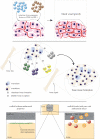Metallic ions as therapeutic agents in tissue engineering scaffolds: an overview of their biological applications and strategies for new developments
- PMID: 22158843
- PMCID: PMC3262432
- DOI: 10.1098/rsif.2011.0611
Metallic ions as therapeutic agents in tissue engineering scaffolds: an overview of their biological applications and strategies for new developments
Abstract
This article provides an overview on the application of metallic ions in the fields of regenerative medicine and tissue engineering, focusing on their therapeutic applications and the need to design strategies for controlling the release of loaded ions from biomaterial scaffolds. A detailed summary of relevant metallic ions with potential use in tissue engineering approaches is presented. Remaining challenges in the field and directions for future research efforts with focus on the key variables needed to be taken into account when considering the controlled release of metallic ions in tissue engineering therapeutics are also highlighted.
Figures
References
Publication types
MeSH terms
Substances
LinkOut - more resources
Full Text Sources
Other Literature Sources


